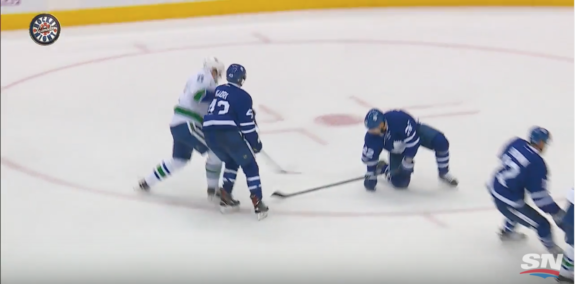Already crucified in the court of public opinion, the Toronto Maple Leafs won’t have to do without Nazem Kadri for any extended period of time after the league announced that there would be no further discipline following his hit on Canucks’ forward Daniel Sedin in last night’s affair.
While his hit was certainly questionable and had the opposing team and its fans up in arms, the league deemed the hit legal and will therefore not look at suspending the Leafs’ forward – a player known for his aggressive play.
Nazem Kadri: Agitator, Aggressor
Just two nights after becoming the overtime hero against the Edmonton Oilers and the go-to shutdown guy for Connor McDavid, Kadri found himself under the league microscope with this hit.
Now, understandably, the Canucks weren’t too happy with the play. In fact, Jannik Hansen (who was the victim of the solid open-ice hit by Morgan Rielly at the beginning of that play) was the one who came over and demonstrated his frustrations with Kadri following the hit.
On top of that, the Canucks were in the midst of losing their eighth game in a row with lacklustre offensive showings over that span. Frustration is certainly building around that team.
That being said, Kadri does have a history of playing on the edge. He’s been suspended three times over his NHL career – totaling 11 games – with the latest coming this past April for cross-checking Detroit’s Luke Glendening.
An extremely polarizing player, Kadri is often criticized for his style of play. He draws a number of penalties and isn’t afraid to get in the face of opposing teams’ top players. However, the hit in Saturday night’s game almost resulted in more missed time for the young forward who’s off to a good start for the Leafs this season with six goals and nine points.
On Wednesday, it was announced by the league (and plastered on social media) that the 26-year-old Kadri wouldn’t face any supplemental discipline for his hit and the commentary began to fill timelines all over the internet.
Some rejoiced while the majority seemed to question the decision not to suspend the edgy forward. Regardless, we’re going to take a further look into the hit that has both Vancouver and Toronto fans looking forward to their second and final matchup this season on December 3.
Breaking Down the Call
Following the hit, which also resulted in a goal by Sedin, Kadri was handed a five-minute major for charging, a five-minute major for fighting and a game misconduct.
Take another look at the video above. While it can certainly be argued that it was a blind side hit, let’s discuss the charging penalty or even the possibility of an illegal headshot.
According to the NHL’s rule 42:
A minor or major penalty shall be imposed on a player who skates or jumps into, or charges an opponent in any manner. Charging shall mean the actions of a player who, as a result of distance traveled, shall violently check an opponent in any manner. A ‘charge’ may be the result of a check into the boards, into the goal frame or in open ice.
Kadri’s hit was in open ice and while he didn’t take any strides leading into the hit, he did catch Sedin in a vulnerable position – as he followed through on his shot. The way that Sedin’s helmet flew off and the magnitude to which he fell to the ice certainly didn’t help the visual aspect of the hit and therefore could be seen as a violent check. There was a fair distance traveled by Kadri to make the hit and for that reason, the officials made the right call on the ice.
However, to those who are calling for a suspension based on an illegal check to the head or a blind side hit, take a look at this still shot from the video above.

The primary point of contact, as you can primarily see in this shot, is body-on-body. Sedin’s head was lower than usual based on the positioning of his body following his shot on the Leafs’ net which did make Kadri’s follow through a lot harsher on the Canucks’ veteran. But it doesn’t fall under the league’s ruling of an illegal headshot.
Likewise, as theScore.com’s Justin Cuthbert writes, the Kadri hit can be seen as a blindside hit but it isn’t exactly illegal in the NHL.
“Damian Echevarrieta, a Department of Player Safety staffer, did touch on the subject on Twitter,” writes Cuthbert. “He underscored that blind side hits are not illegal in the NHL, and that the angle taken is irrelevant as long as the head is not the main point of contact.”
Having already discussed that and the penalty handed out at the time of the incident, it seems reasonable that Kadri wasn’t penalized further than what he was given during the game. That along with the fact that Sedin returned, showing no lasting head trauma almost certainly played a role in the league’s final decision.
https://twitter.com/draglikepull/status/795300140391211008
While the Canucks and GM Jim Benning released a statement saying they disagree with the ruling, Benning did note that they must accept the decision and move on from it. Both teams will certainly remember this moving forward and leading up to their next game against each other next month.